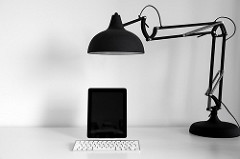The Next Business Pitch: Make it Memorable
It started off as most things do, with a casual discussion about technology on a Friday afternoon in the office of a SVP of a NYC PR agency. The topic of discussion – iPads.
After a bit of discussion, we wandered off on a tangent. “You know one if these days a restaurant is going to start using iPads as menus,” I predicted.
I was, perhaps expectedly, mocked by some others in the room who pointed out the low cost of printing, learning curve issues with the iPad, potential (and ease) of breakage, along with other issues that would prevent adoption. They were right on the specific objections, but I still had faith in using this technology as part of a successful sales (and marketing) strategy.
Then, lo and behold, a few short weeks later The New York Times runs a story about an Atlanta steakhouse that has taken their extensive wine list (over 1300 labels) and loaded it onto iPads. As you might expect, a menu on an iPad does not provide static content. The menu app provides detailed information on each wine including reviews from wine writers. Further, patrons are able to search for a wine by name, region, price and a host of other factors.
The end result – wine purchases were up nearly 11 percent per diner in the first two weeks compared to the weeks immediately prior. There was no other identifiable cause.
What’s next — my bet (for whatever it’s worth) is for iPads to start replacing traditional menus in high-end restaurants, particularly those specializing in foreign cuisine. Consider how often you’ve wondered the difference between two menu items, even though the answer was plainly staring you in face…in Cantonese.
But how can we bring this lesson into our B2B world? Think back to the last large account you (or a client of yours) pitched.
Consider the financial and time resources spent on presentations, research, flights, hotels, ground transportation, printing, shipping and courier bills. This is the cost of doing business. We all know it. Weeks of research, hundreds of man-hours to prepare yourself and your team for a few hours in front of the potential client’s board and the opportunity to … leave behind a velobound version of your deck.
Some of you know where I’m going with this.
Or, instead of those 80 velobound pages and CD envelope within — cough up the $500 and buy the newest trinket at the candy store — the (beloved by many) iPad.
Load it down with your content – specialized information and apps, videos, product photos, detailed descriptions, company history, whitepapers, case studies, hyperlinks to specific websites, any and everything you’ve got that can’t possibly fit in a traditional deck because of its innate limitations. For good measure you should probably also include the deck you’ll be presenting at the actual meeting.
This preloaded iPad is now either a) Your ‘ground softening’ advance set of documents you send to the (about to be your) client or b) your ‘leave-behind’ toy after you’ve given your presentation.
In either circumstance – what do you think the odds are your prospect won’t pick it up, use it and in the process find out all about your services and your company.
- Is it an exorbitant amount to spend on a single item in a presentation? Perhaps. Does it matter? No
- Is it the item that will win you the business? Unlikely, but possibly
- Is it a way to nearly ensure your prospect sees your materials? Yes
- Is it a way to differentiate yourself from your competitors? Yes – You wouldn’t be shaking your head so hard if it wasn’t sufficiently different
An iPad won’t win you the business. However, having the prospect realize which suitor takes appropriate risks, gives a project their all and thinks ahead of the curve? That, on the other hand, just might.
How much is an overnight 11 percent increase in sales worth to you?
Image courtesy thms.nl
